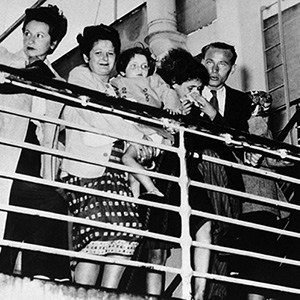Ohef Sholom Temple Archives Passengers of the S.S. Quanza, docked in Norfolk harbor, 1940, while their fate hangs in the balance, prohibited by US immigration law from disembarking.
This past Wednesday, September 11, marked 79 years since a rejected refugee ship arrived on Tidewater’s shores, sparking a battle of wills that reached all the way to the White House, and the narrow rescue of 81 refugees fleeing the horrors of Nazi-occupied Europe.
For Elise Margolius, a young wife, mother, and president of the Norfolk Council of Jewish Women (NCJW), the war in Europe was an ocean away. By 1940, Americans had finally begun to emerge from the Great Depression. In New York, the World’s Fair’s official theme song proclaimed, “Better times, here to stay, as we live and laugh the American way.” Yet, the song also contained the lyric “Tell the world, at the door, that we don’t want him ‘round anymore.”
While Margolius, along with NCJW members Justine Nusbaum, Doris Kaufman, and Bertha Snyder, to name a few, hosted classes to assist Orthodox immigrants integrate into the community, America’s isolationism had reached fever pitch. Gallup polls showed a majority favored tighter immigration restrictions.
Anti-immigration paralleled a peak in anti-Semitism since between 1939 and 1940 “more than 50% of all immigrants to the United States identified themselves as Jewish” according to the United States Holocaust Memorial Museum.
The outbreak of World War II in 1939 stoked fears of a flood of Jewish immigrants. In response, 20,000 pro-Nazi Americans rallied in Madison Square Garden. KKK membership swelled. Hotels and clubs posted ‘restricted membership.’ The fact that it was an election year with President Roosevelt running for an unprecedented third term only heightened national tensions.
Even in Tidewater’s newly established United Jewish Fund (predecessor to the United Jewish Federation of Tidewater), members disagreed on the overseas issue: “We feel that in the zealousness of your desire to aid our stricken brethren in European lands, you have inadvertently placed too small an emphasis on the needs of [our local] institutions.”
Into this tension, upheaval, and fear, the S.S. Quanza docked at the coal pier at Sewell’s point to refuel on September 11, 1940. The steamship carried 81 refugees, both Jewish and gentile, who had escaped occupied Europe by purchasing transit visas to reach Mexico. Arriving in Vera Cruz, their visas were denied. Inquiries to other ports were similarly rejected. The situation was quickly shaping up to be a repeat of the M.S. St. Louis. The St. Louis was another refugee ship whose Jewish passengers had also been rejected on arrival the previous year. At the last minute on the ship’s return to Nazi Germany, Western European countries accepted the St. Louis’ passengers. By 1940, the Nazis had invaded, and many of the former passengers were sent to concentration camps. The last refuge in Europe was gone.
The Jews of Tidewater had never encountered anything like this before, but they didn’t hesitate. Elise Margolius organized an emergency committee alongside the National Refugee Service (NRS) to bring the Quanza fresh supplies. A local maritime lawyer, Jacob Morewitz, filed a libel suit on behalf of the passengers against the shipping company, which would have to pay bail before the ship could be allowed to leave. The action bought the refugees a few days, but they remained stuck on the ship. As soon as the company wired the money, it would return its passengers to Nazi-occupied Europe. Something more needed to be done.
Thanks to the outcry from Margolius’ NCJW, the NRS, and other Jewish organizations, word reached First Lady Eleanor Roosevelt. Deeply disturbed by her country’s failure to help the M.S. St. Louis and driven by her own humanitarianism, Roosevelt implored President Roosevelt to act. The President considered his hands tied by public opinion and an isolationist Congress. He appointed a representative, Patrick Malin, in cooperation with the State Department, to travel to Norfolk to determine whom among the refugees could qualify for entry via the emergency visa program.
The qualifications were determined by Assistant Secretary of State Breckinridge Long. An isolationist, Long had quietly begun consolidating his authority over refugee affairs to drastically reduce the numbers admitted to the United States. With only a few days left before the Quanza would depart, Long was confident his list of screening criteria would prevent the refugees from escaping in time.
Immigration officials alongside Malin, Margolius, and other local representatives worked tirelessly to screen and vet the refugees. Malin confirmed that all the necessary paperwork was in order and using the parameters given to him for determining political refugees, certified all 81 passengers qualified to disembark.
When Long learned of the refugees’ certifications, he was enraged. As he wrote in his diary, “I remonstrated violently,” and said “I thought it was a violation of the Law…that I would not give my consent.” When Long tried to stop it, Malin informed him it was too late— the passengers were already unloading. The men, women, and children stepped onto American soil, laughing and crying. Margolius took a family home with her that night so they could spend their first night of freedom in a real bed.
The next day, Margolius and her neighbor Herbert Gerst invited the passengers to breakfast before they departed for various destinations in the United States. Margolius, who passed away in 2002 at the age of 99 after a lifetime of community service, never forgot that moment—“I can see their happy, smiling faces, waving American flags as they waved goodbye and the bus pulled away…we all just wept.”
For First Lady Eleanor Roosevelt, whose deepest regret at the end of her life was that she could not have saved more, this was a victory. For the refugees and their descendants, this was the gift of life.
Jewish News Staff

